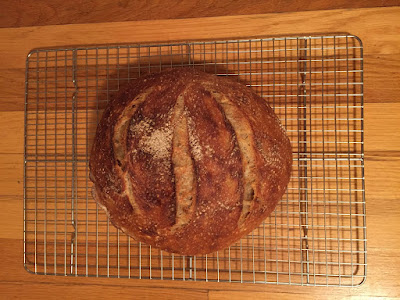 |
| I made this! |
Friends have been asking me what I’ve been doing lately. Sometimes I answer straightforwardly: I’m freelancing a little. Thinking about what I want to do next. But that’s a boring answer. So other times I just say that I’m baking a lot of bread.
And it’s true, I’m suddenly quite taken with bread. I’ve cooked for a long time, but baking never interested me until now. The effort-to-results ratio didn’t seem worth it, especially in a city where excellent bread was so easily procured. But in November I went to fermentation fantasy camp in Tennessee. On the last day, when everyone was breaking down their tents and arranging rides to the airport, Sandor set up a little fermentation starter buffet on the kitchen island. He put out kefir grains, koji, yogurts, tibicos, tempeh spores, and sourdough starter. What the hell, I thought, and spooned some of the sourdough into a ziplock bag, then tucked it into a mitten for the long journey home.
The first loaf I made—and each one I’ve made since—was Tartine's country bread. The recipe in Tartine's cookbook is 38 pages long, but I use an abridged, though still quite complicated version (see for yourself). Before you can even begin the recipe, you have to feed the starter, which consists of discarding the entire starter save for one tablespoon, then adding equal parts flour and water to that. It takes several feedings, spaced 12 or so hours apart, before the starter becomes bubbly enough to bake with. Once that happens, you feed it again, wait a while, gently fold it, shape it, whisper incantations to it, flip it over, put it in a towel-lined basket, and finally bake it. Before each successive step, you have to check that the dough has reached certain milestones: that it’s increased in volume a certain amount, or it doesn’t bounce back when you poke it, or a spoonful of it floats in a bowl of water. The process is absurd, but the resulting bread is transcendent.
Even though this is one of the longest recipes I’ve ever encountered, it doesn’t nearly cover everything I need to know. All cooking is about observation; you have to notice things like the slant of your stove, if your cabbage seems a little on the dry side, if the butcher sliced your meat too thin. But baking bread is especially so, and maddeningly so. In the beginning, I had a 50% success rate. The bread needs to rise in a warm environment, and I struggled to find a spot warm enough but not too warm. Twice I ruined the dough by overheating it. As soon as I checked it I could tell what had happened by how ragged and sticky the dough had become. I was too far into the recipe to quit, so I pressed on, resigned to deliver a stillborn-loaf. (I finally learned to put it on top of the radiator with two folded towels underneath.)
Five loaves in, I see bread differently than I used to. I mean that literally: struggling and suffering and cursing through the process of baking has made the final loaf appear visually different to me. The texture of the crumb, the color of the crust, those elegant scores over the surface: before I started baking, all of those things were just "bread" to me. Now I see each of them as distinct.
I drew a lot when I was younger, and my art teacher Marya taught me exercises to help me see better. Sometimes, when we were drawing a live model, Marya would forbid me from looking at my page. Stop worrying about whether her breast looks like a breast, she’d say. Don’t draw a breast, draw that weird thing that is Merav’s breast.
Marya showed me how to see by making everything unfamiliar. But with bread, I’m learning that the opposite is also true. When I first started baking sourdough, everything was so new it was almost blinding. But as I fumbled my way through the 13 steps of the recipe, I built intimacy with the process, especially the parts that I fucked up. The more routine bread becomes, the better I can read it.
Make sure you have precautions in place for when the bread decides to poke you back.
ReplyDeleteNice postt thanks for sharing
ReplyDelete